#232: Gyromitra brunnea

Gyromitra brunnea is a false morel (see FFF#034) that is fairly common in the eastern and midwestern parts of North America. Like the other false morels, it has a solid to chambered stipe and a wrinkly head. The thing that sets G. brunnea apart, however, is that the cap is highly lobed and there are white seams along the edges of the lobes. No other false morels feature these seams, making G. brunnea easy to identify.1,2
Description
Like other false morels, G. brunnea mushrooms have two parts: a stipe and a cap (or head). The stipe grows up to 10cm tall and 9cm thick. The cap grows up to 9cm tall and 12cm wide. These proportions mean that the head hangs down over most of the stipe and that the stipe is typically almost as wide as the cap. Overall, the mushroom has a stocky appearance.1,2
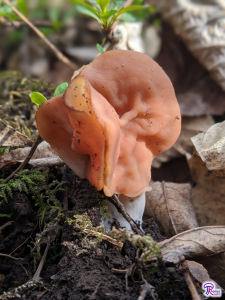
The cap is tan to reddish brown on the outer surface and whitish and powdery on the undersurface. There are usually several lobes on the head that curve away from the center of the mushroom and into the air. The points of the lobes look like what happens if you drape a tablecloth over a table and pull up one of the corners: there is an upper ridge that is solid, but the outside edge has a gap where the two edges of the tablecloth meet. The gap is narrow at the tip but widens as the two edges of the fabric curve away toward the ground. In G. brunnea, this formation results in seams along the edges of the lobes where the white undersurface is visible. The surface of the lobes is wrinkled, though some specimens are more highly wrinkled than others.1,2 Typically, the mushroom develops more lobes and more wrinkles as it ages. The flesh in the cap is brittle and breaks easily.1,2
The stipe is white on the outside and roughly cylindrical but with many rounded column-like lobes. Underneath the cap, the stipe develops numerous buttress-like ridges that fuse with the cap at multiple points. The stipe looks solid from the outside, but when you cut it open you can clearly see this is not the case. Inside, the stipe features many convoluted hollow chambers. The flesh inside the stipe is whitish and has a fleshy texture – it is firmer than flesh in the cap. The stipe typically enlarges where it meets the ground and seems to fade away into the ground rather than having a defined base.1,2 As a result, the base of the stipe usually includes more dirt than fungal tissue.
Ecology
You can find G. brunnea in the spring in eastern and midwestern North America growing on the ground near stumps and other dead wood of hardwoods. I most often find these mushrooms around dead hardwood trees, especially hickory and elm. The largest G. brunnea mushroom I found was next to an oak log under an ash tree. Of course, they also appear at random times in forests, such as beside trails. Because of its habitat preference, G. brunnea is assumed to be saprobic. However, it does appear in similar habitats to morels (see FFF#033), which can be saprobic or mycorrhizal at different times. This might indicate that G. brunnea can also be mycorrhizal sometimes.1
Similar Species
You’re most likely to confuse G. brunnea with other false morels, such as G. caroliniana (FFF#209), G. korfii, and G. montana. All these species have a thick stipe that is nearly as large as the head and have a wrinkly brownish head. However, only G. brunnea has a head with seams along the edges of the lobes. If G. brunnea looks like a tablecloth with the corners held up, these other species look more like a bedsheet ghost costume: there are very few (if any) lobes, no seams at all, and you usually can’t see the underside without picking up the mushroom.3
There are a few other species of false morels in North America, but these are easier to differentiate. G. esculenta and a few other false morels can be easily distinguished by their thin stipes. These species have a cap that is much wider than the stipe, while G. brunnea has a stipe that is about the same width as the head.3
The remaining species of Gyromitra are also easy to distinguish. G. infula and G. ambigua have thin stipes and heads with a few large distinct lobes, making them look more saddle-shaped. G. perlata and a few others lack stipes entirely, making them cup fungi.3
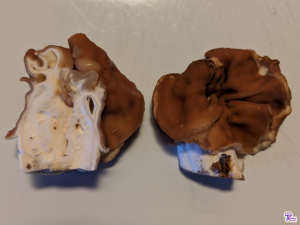
Morels can also appear somewhat similar, although their heads feature distinct ridges and pits. The easiest way to tell the difference between a morel and a false morel is to cut them in half from top to bottom. Morels will have a single hollow cavity that extends from the base of the stipe to the top of the cap and the cap will be attached to the stipe at the bottom of the cap (or halfway up the cap in the case of the half-free morels, see FFF#211).4 By contrast, false morels will have a stipe that is solid or chambered and a cap that is attached at the very tip or at multiple points (the head of G. brunnea is attached at multiple points).1,2
Verpas (FFF#067) are also similar to false morels. Like with morels, the easiest way to tell these species apart is by cutting them from top to bottom. Verpas have a head that attaches just at the very tip of the stipe and hangs down around the stipe like a thimble on a finger. The stipe of a verpa is filled with cottony material, although it can appear solid when young and hollow when old.4 Verpas also tend to be much smaller than false morels.
Edibility
There is a lot of debate surrounding the edibility of G. brunnea (and false morels in general). G. esculenta is known to contain the toxin gyromitrin (see FFF#092), and it has generally been assumed that all species of Gyromitra contain gyromitrin. However, there is a growing number of people who report eating some species of Gyromitria without experiencing poisoning. We don’t have any numbers on people who eat Gyromitra without poisoning symptoms, but we do have numbers on confirmed poisoning cases. G. brunnea has only one poisoning report in the North American Mycological Association’s (NAMA’s) poisoning database and it was a mild case.5 Because of this, Michael Beug, the chair of NAMA’s toxicology committee, recommends that G. brunnea be considered to have the same toxic status as morels: poisonous when raw, edible when thoroughly cooked.6 However, there are no scientific studies assessing G. brunnea for the presence of toxins, so the debate is not yet settled.
I have tried this species a few times (well-cooked and in small quantities) without any noticeable ill effects. However, this could be because the local strain didn’t make the toxin or made very little toxin. It’s possible that strains from other areas might produce more gyromitrin. Or it could be that I didn’t eat enough to feel the effects. Or it could be that the gyromitrin evaporated during cooking (which can be just as dangerous if you breathe in the fumes). So, my experience won’t necessarily apply everywhere or to everyone – please carefully consider the risks before trying this mushroom.
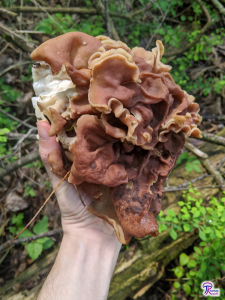
In case you decide to try eating these mushrooms, you need to be aware of the symptoms of gyromitrin poisoning so you can get help quickly if you need it. Symptoms begin 2-24 hours after ingesting the mushrooms or inhaling cooking fumes. They typically include severe headaches, GI upset, vomiting, and severe diarrhea. Sometimes the toxin is more insidious, causing damage to red blood cells, the liver, and/or the kidneys, any one of which can result in death.7
Additionally, gyromitrin is a carcinogen and therefore could cause or contribute to cancer over the long term.7 This is perhaps more worrisome than the immediate toxic effects of the poison.
As always, if you experience mushroom poisoning, seek treatment first. Then, report it to NAMA here so that your experience is recorded. This will help everyone get a better idea of which species of mushrooms are poisonous.
So, what’s it like eating G. brunnea? I find G. brunnea to have a decent flavor: it’s kind of meaty with a lot of umami, but otherwise isn’t very distinctive. Unfortunately, it’s not a very easy mushroom to work with. It has brittle flesh (especially in the cap), which means you often end up with smaller pieces than you want. (I managed to improve the texture – accidently – by leaving one mushroom in the refrigerator for a few days.) Additionally, you have to do a lot of work to prepare G. brunnea. Since it has a chambered stipe, insects and spiders like to hide in it. Rinsing it off isn’t enough to get rid of them, since the water won’t reach every chamber. To get rid of all the bugs you need to slice it and wash every slice. Additionally, the stipe of G. brunnea tends to embed a lot of dirt. Cutting the mushroom off at the base doesn’t work because somehow the dirt gets drawn up into the flesh underneath the cap. Removing all the dirty tissue can take a lot of time and you end up throwing away a good chunk of your mushroom.
For more information on edibility, preparation, and cooking of Gyromitra species, see this Forager Chef post about them.
Overall, it’s probably best to stay safe and not eat this mushroom. That is the best way to avoid any potential toxic and carcinogenic effects. You won’t miss much and there are better edible mushrooms out there in the spring.
Taxonomy
G. brunnea belongs to the family Discinaceae, which includes elfin saddles, false morels, and numerous cup fungi. This family is placed in the order Pezizales, which includes most cup fungi as well as morels and verpas. Fungi in this order are known for their ability to produce puffs of spores when you blow on them. You don’t see this very often in the larger mushrooms in the order, but I recently managed to get a video of G. brunnea releasing a puff of spores (see the video above). To learn more about how this works, see my page on cup fungi (FFF#032).
You may see the name G. fastigiata used for this mushroom, but mycologists consider that to be a European name.
| Kingdom | Fungi |
| Subkingdom | Dikarya |
| Division (Phylum) | Ascomycota |
| Subdivision (Subphylum) | Pezizomycotina |
| Class | Pezizomycetes |
| Subclass | Pezizomycetidae |
| Order | Pezizales |
| Family | Discinaceae |
| Genus | Gyromitra |
| Species | Gyromitra brunnea Underw.8 |
This post is not part of a key and therefore does not contain enough information to positively identify any mushroom. When collecting for the table, always use a local field guide to identify your mushrooms down to species. If you need a quality, free field guide to North American mushrooms, I recommend Michael Kuo’s MushroomExpert.com. Remember: when in doubt, throw it out!
Do not use information in this post to self-diagnose or self-treat a medical complaint. Always consult a licensed medical doctor for proper diagnosis and treatment of a health issue.
See Further:
https://www.mushroomexpert.com/gyromitra_brunnea.html
https://foragerchef.com/on-cooking-false-morels-gyromitra/
https://www.fungimag.com/spring-2014-articles-02/V7I1%20LR%20FalseMorels28-31pdf.pdf
https://namyco.org/mushroom_poisoning_syndromes.php#gyro
Citations
- Kuo, M. Gyromitra brunnea. MushroomExpert.Com https://www.mushroomexpert.com/gyromitra_brunnea.html (2012).
- Beug, M. W., Bessette, A. & Bessette, A. R. Ascomycete fungi of North America: a mushroom reference guide. (2014).
- Kuo, M. Gyromitra: The false morels. MushroomExpert.Com https://www.mushroomexpert.com/gyromitra.html (2012).
- Kuo, M. The Morchellaceae: true morels and verpas. MushroomExpert.Com https://www.mushroomexpert.com/morchellaceae.html (2012).
- Beug, M., Shaw, M. & Cochran, K. Thirty plus years of mushroom poisoning: summary of the approximately 2,000 reports in the NAMA case registry. McIlvainea 16, 47–68 https://namyco.org/docs/Poisonings30year.pdf (2006).
- Beug, M. W. False morels — age-old questions of edibility: a primer. FUNGI vol. 7 28–31 https://www.fungimag.com/spring-2014-articles-02/V7I1%20LR%20FalseMorels28-31pdf.pdf (2014).
- Mushroom poisoning syndromes. North American Mycological Association https://namyco.org/mushroom_poisoning_syndromes.php#gyro.
- Gyromitra brunnea. Mycobank http://www.mycobank.org/Biolomics.aspx?Table=Mycobank&Rec=317380&Fields=All.

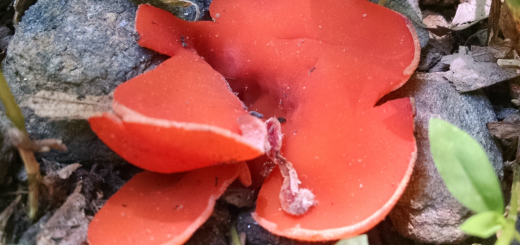
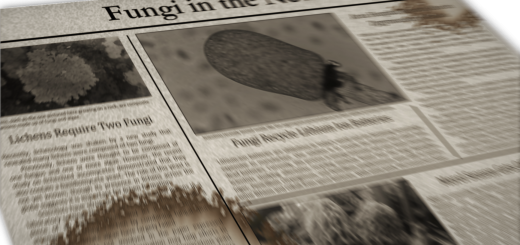






![#011: Characteristics of Kingdom Fungi [Archived]](https://www.fungusfactfriday.com/wp-content/themes/hueman/assets/front/img/thumb-small-empty.png)
